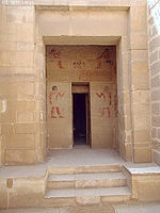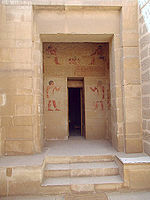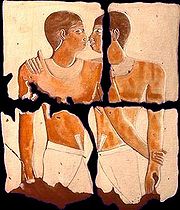
Khnumhotep & Niankhkhnum
Encyclopedia

Pharaoh
Pharaoh is a title used in many modern discussions of the ancient Egyptian rulers of all periods. The title originates in the term "pr-aa" which means "great house" and describes the royal palace...
s, circa 2400 BCE, and are listed as "royal confidants" in their joint tomb.
Family
Khnumhotep and Niankhkhnum are depicted in the tomb with their respective families. It has been proposed that they were the sons of Khabaw-khufu and Rewedzawes. They appear to have had three brothers named Titi, Nefernisut, and Kahersetef. Three possible sisters are also attested. They are named Neferhotep-hewetherew, Mehewet and Ptah-heseten.Niankhkhnum's wife was named Khentikawes. They appear in the tomb with three sons named Hem-re, Qed-unas and Khnumhezewef. Three daughters are mentioned as well and their names are Hemet-re, Khewiten-re and Nebet. At least one grand-son is mentioned. Irin-akheti was the son of Hem-re and his wife, Tjeset.
Khnumhotep had a wife by the name of Khenut. Khnumhotep and Khenut had at least five sons named Ptahshepses, Ptahneferkhu, Kaizebi, Khnumheswef and Niankhkhnum -the younger (named after his uncle) as well as a daughter named Rewedzawes.
The Tomb

Ahmed Moussa (Egyptologist)
Ahmed Mahmoud Moussa was an Egyptian Egyptologist. Born in Damietta on 15 August 1934, Moussa received his B.A. in Egyptology in 1959 from Cairo University, and his PhD from the Eötvös Loránd University at Budapest in 1995....
in the necropolis
Necropolis
A necropolis is a large cemetery or burial ground, usually including structural tombs. The word comes from the Greek νεκρόπολις - nekropolis, literally meaning "city of the dead"...
at Saqqara, Egypt in 1964, during the excavation of the causeway for the pyramid of King Unas
Unas
Unas was a Pharaoh of Ancient Egypt, and the last ruler of the Fifth dynasty from the Old Kingdom. His reign has been dated as falling between 2375 BC and 2345 BC...
. It is the only tomb
Tomb
A tomb is a repository for the remains of the dead. It is generally any structurally enclosed interment space or burial chamber, of varying sizes...
in the necropolis where men are displayed embracing and holding hands. In addition, the men's chosen names (both theophorics to the creator-god Khnum) form a linguistic reference to their closeness:
Niankhkhnum means "joined to life" and Khnumhotep means "joined to the blessed state of the dead'", and together the names can be translated as "joined in life and joined in death"
In a banquet
Banquet
A banquet is a large meal or feast, complete with main courses and desserts. It usually serves a purpose such as a charitable gathering, a ceremony, or a celebration, and is often preceded or followed by speeches in honour of someone....
scene, Niankhkhnum and Khnumhotep are entertained by dancers, clappers, musicians and singers; in another, they oversee their funeral preparations. In the most striking portrayal, the two embrace, noses touching, in the most intimate pose allowed by canonical Egyptian art
Art of Ancient Egypt
Ancient Egyptian art is the painting, sculpture, architecture and other arts produced by the civilization in the lower Nile Valley from 5000 BC to 300 AD. Ancient Egyptian art reached a high level in painting and sculpture, and was both highly stylized and symbolic...
, surrounded by what would appear to be their heirs. The superstructure of their tomb
- "was almost completely destroyed because king UnasUnasUnas was a Pharaoh of Ancient Egypt, and the last ruler of the Fifth dynasty from the Old Kingdom. His reign has been dated as falling between 2375 BC and 2345 BC...
built his [tomb] causeway over it. It has been reconstructed using the decorated blocks that were found during excavation, and is now open to the public. The part of the tomb that was put into the rock is well preserved. The quality of the painted reliefs is excellent, especially in the first of the rock cut chambers. The various scenes on the western side of the tomb include fishing and fowling in the marshes, stock breeding, papyrus gathering and fights among the boatmen. opposite are agricultural scenes and scenes of sculptors and jewellers at work."
Pillared Entrance
The façade of the mastaba is made up of a pillared portico. The front is inscribed and Niankhkhnum is depicted on the right, while Khnumhotep is depicted on the right. The inscriptions accompanying the men is virtually identical, with only the names being different.First vestibule
This space is fairly small. The west side is decorated with a funerary procession for Niankhkhnum and the east side shows a matching funerary procession for Khnumhotep.The south wall shows the two men seated before an offering table. Niankhkhnum is seated on the right, while Khnumhotep is seated on the left. The table with offerings stretches out between them. Below the offering scene the two men are depicted hunting and fishing. On the left Khnumhotep stands on papyrus boat. He is accompanied by his wife Khenut and a son and daughter. On the right Niankhkhnum is depicted in a similar manner. He is accompanied by his wife Khentkawes and a son and daughter as well.
First and Second Chamber
At the entrance scenes of baking bread and brewing beer are depicted. Barley is carefully measured out and turned into bread. Some of the bread is mixed with a date beverage and fermented to produce some type of beer.Other scenes include goat herding, ship building, harvesting scenes, sailing, netting of birds, etc.
The east wall contains a legal text. Below this text several people are depicted thought to be the family of the two men. At the very bottom ships are shown. The men are shown standing before the main cabin of the ship.
Antechamber and Offering Chamber
The antechamber is a fully decorated rock-cut room. The scenes show people in agricultural scenes including the weighing of corn and grain, the ploughing of the fields and harvesting.A pillar depicts the two men with their children. The respective wives are not depicted in this scene. Niankhkhnum’s three sons and three daughters are depicted behind him. The inscriptions give their respective names. Similarly Khnumhotep’s five sons and one daughter appear behind him.
Proposed homosexuality

History
History is the discovery, collection, organization, and presentation of information about past events. History can also mean the period of time after writing was invented. Scholars who write about history are called historians...
.
The proposed homosexual nature of Khnumhotep and Niankhkhnum has been commented on the popular press, and the idea seems to (partially) stem from the depictions of the two men standing nose to nose and embracing. Niankhkhnum's wife, depicted in a banquet scene, was almost completely erased in ancient times, and in other pictures Khnumhotep occupies the position usually designated for a wife. Their official titles were "Overseers of the Manicurists of the Palace of the King".
Critics argue that both men appear with their respective wives and children, suggesting the men were brothers, rather than lovers.
Literature
- A. M. Moussa and H. Altenmüller, Das Grab des Nianchchnum und Chnumhotep, Mainz 1977
External links
- The mastaba of Niankhkhnum and Khnumhotep by J. Hist on Osirisnet.net
- Gallery and background, egyptology.com
- References and bibliography, egyptology.com
- "Mwah . . . is this the first recorded gay kiss?" The Sunday Times, January 1, 2006
- "Evidence of gay relationships exists as early as 2400 B.C." The Dallas Morning News, July 20, 1998
- "Same-Sex Desire, Conjugal Constructs, and the Tomb of Niankhkhnum and Khnumhotep," Greg Reeder, World Archaeology, Vol. 32, No. 2, Queer Archaeologies (Oct., 2000), pp. 193–208

